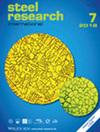CaO-SiO2-Al2O3-MgO 系统包裹体的结晶行为
IF 1.9
3区 材料科学
Q2 METALLURGY & METALLURGICAL ENGINEERING
引用次数: 0
摘要
在连铸和热轧过程中,低熔点 CaO-SiO2-Al2O3-MgO 系夹杂物的结晶过程对夹杂物的变形性影响很大。本文系统研究了 Al2O3 和 MgO 含量对代表 Si-Mn 脱氧钢中典型氧化物夹杂物的 CaO-SiO2-Al2O3-MgO 系熔体结晶特性的影响。进行了连续冷却转变和时间-温度转变实验。结果表明,Al2O3 含量的增加抑制了熔体的结晶过程,而 MgO 含量的增加则促进了熔体的结晶趋势。析出相主要为 2CaO-MgO-2SiO2 和 3CaO-MgO-2SiO2,主晶相不受 Al2O3 和 MgO 含量变化的影响。为了获得结晶能力有限的低熔点塑化夹杂物,建议将 Al2O3 和 MgO 的含量分别控制在 15 wt% 以上和 5 wt% 以下。建议将等温处理控制在适当的温度范围内(1175-1250 °C),以降低结晶动力学。氧化物体系的粘度变化是结晶过程中的限制动力学因素,可用于预测体系的结晶趋势。本文章由计算机程序翻译,如有差异,请以英文原文为准。
Crystallization Behavior of the CaO–SiO2–Al2O3–MgO System Inclusions
The crystallization process of low melting point CaO–SiO2 –Al2 O3 –MgO system inclusions during the continuous casting and hot rolling process greatly affects the deformability of inclusions. The effect of Al2 O3 and MgO contents on the crystallization characteristics of CaO–SiO2 –Al2 O3 –MgO system melts representing the typical oxide inclusions in Si–Mn deoxidized steels is systematically investigated. The continuous cooling transformation and time–temperature transformation experiments are carried out. The results reveal that the increase of Al2 O3 contents restrains the crystallization process of the melt, whereas the crystallization tendency of the melt is promoted with the increase of MgO contents. The precipitated phases are predominately 2CaO·MgO·2SiO2 and 3CaO·MgO·2SiO2 , and the primary crystalline phase is unaffected by the changes of Al2 O3 and MgO contents. To obtain low melting point plasticized inclusions with limited crystallization ability, it is recommended to control the Al2 O3 and MgO contents greater than 15 wt% and below 5 wt%, respectively. The isothermal treatment is suggested to be controlled within a proper temperature range (1175–1250 °C) to decrease the crystallization kinetics. The oxide system's viscosity change is the limiting kinetic factor in the crystallization process, and it can be utilized to predict the system's crystallization tendency.
求助全文
通过发布文献求助,成功后即可免费获取论文全文。
去求助
来源期刊

steel research international
工程技术-冶金工程
CiteScore
3.30
自引率
18.20%
发文量
319
审稿时长
1.9 months
期刊介绍:
steel research international is a journal providing a forum for the publication of high-quality manuscripts in areas ranging from process metallurgy and metal forming to materials engineering as well as process control and testing. The emphasis is on steel and on materials involved in steelmaking and the processing of steel, such as refractories and slags.
steel research international welcomes manuscripts describing basic scientific research as well as industrial research. The journal received a further increased, record-high Impact Factor of 1.522 (2018 Journal Impact Factor, Journal Citation Reports (Clarivate Analytics, 2019)).
The journal was formerly well known as "Archiv für das Eisenhüttenwesen" and "steel research"; with effect from January 1, 2006, the former "Scandinavian Journal of Metallurgy" merged with Steel Research International.
Hot Topics:
-Steels for Automotive Applications
-High-strength Steels
-Sustainable steelmaking
-Interstitially Alloyed Steels
-Electromagnetic Processing of Metals
-High Speed Forming
 求助内容:
求助内容: 应助结果提醒方式:
应助结果提醒方式:


